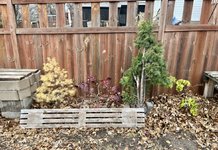DrTolhur
Mame
As with anything, bonsai obviously carries with it plenty of varied advice as far as what works and what doesn't. And for things like soils, fertilizer, etc., I'm sure there's lots of things that work, and part of it depends on things like what water you use, how often you water, and whatnot. People can kind of try things and see what gives good enough results for their liking. And you get feedback within the season as far as how the tree responds.
But there's one thing that I can't understand why there's varied advice on, which is hardiness of trees to winter temperatures. Specifically: some sources say Japanese maple roots will die if they get below 15ºF. Then other people say they leave them outside, largely unprotected when it's around 0ºF for days on end. These seem unreconcilable. Any tree will die at some temperature, but what is it? Does a root temperature of 15ºF kill Japanese maples or not? If not, why do people say it does?
Here are some of my guesses as to why they differ so much, but I'd love to hear input if anyone else has better knowledge or specific experience (i.e. lost Japanese maples due to cold):
- Sources saying to keep above 15ºF just being overly conservative.
- Healthy trees can survive colder temperatures (below 15ºF) better than weaker trees.
- Larger trees are hardier.
- Being on the ground might give enough thermal boost to keep roots above 15ºF even when air temperatures are well below that for extended periods.
- Sometimes trees just die with no obvious cause, and someone guessed it was because of temperature.
But there's one thing that I can't understand why there's varied advice on, which is hardiness of trees to winter temperatures. Specifically: some sources say Japanese maple roots will die if they get below 15ºF. Then other people say they leave them outside, largely unprotected when it's around 0ºF for days on end. These seem unreconcilable. Any tree will die at some temperature, but what is it? Does a root temperature of 15ºF kill Japanese maples or not? If not, why do people say it does?
Here are some of my guesses as to why they differ so much, but I'd love to hear input if anyone else has better knowledge or specific experience (i.e. lost Japanese maples due to cold):
- Sources saying to keep above 15ºF just being overly conservative.
- Healthy trees can survive colder temperatures (below 15ºF) better than weaker trees.
- Larger trees are hardier.
- Being on the ground might give enough thermal boost to keep roots above 15ºF even when air temperatures are well below that for extended periods.
- Sometimes trees just die with no obvious cause, and someone guessed it was because of temperature.



